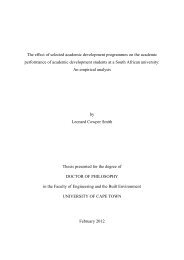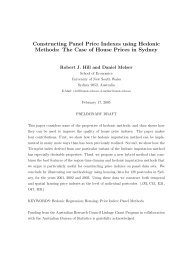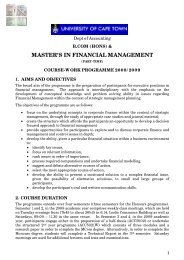Competition and Regulation in the Telecommunications Industry in ...
Competition and Regulation in the Telecommunications Industry in ...
Competition and Regulation in the Telecommunications Industry in ...
You also want an ePaper? Increase the reach of your titles
YUMPU automatically turns print PDFs into web optimized ePapers that Google loves.
<strong>Competition</strong> <strong>and</strong> <strong>Regulation</strong> <strong>in</strong> <strong>Telecommunications</strong>Aga<strong>in</strong> <strong>the</strong> key question is how will <strong>the</strong> market change if entry was liberalised.In answer<strong>in</strong>g this question for mobile, it is important to separate <strong>the</strong> networkprovision from <strong>the</strong> service provision, as <strong>the</strong> barriers to entry are considerablydifferent.Barriers to entryIn <strong>the</strong> network component <strong>the</strong> barriers to entry <strong>in</strong>clude:• Sunk costs – if <strong>the</strong> network provider is required to roll out a completenationwide network (as is <strong>the</strong> case <strong>in</strong> South Africa), <strong>the</strong>n <strong>the</strong> sunk costswill clearly be high. However, with mobile, as opposed to fixed l<strong>in</strong>e, <strong>the</strong>level of <strong>in</strong>frastructure required depends on <strong>the</strong> level of traffic (see section1). The result is that <strong>the</strong>re is a lower <strong>in</strong>vestment required to launch aservice, but which can rise <strong>in</strong> proportion to <strong>the</strong> growth <strong>in</strong> subscribers. Thismakes entry easier <strong>and</strong> more likely that <strong>the</strong> <strong>in</strong>dustry can support morethan one or two network providers. A fur<strong>the</strong>r means of eas<strong>in</strong>g <strong>the</strong> entry ofa new network is to allow <strong>the</strong> use of <strong>in</strong>frastructure from compet<strong>in</strong>g networkproviders until a full network is up <strong>and</strong> runn<strong>in</strong>g. The reduction <strong>in</strong> time toenlist subscribers means that <strong>the</strong> entrant can start generat<strong>in</strong>g a return on<strong>the</strong>ir <strong>in</strong>vestment sooner, <strong>the</strong>reby lower<strong>in</strong>g costs of establishment.• Interconnection pric<strong>in</strong>g – as with any network, a mobile network needs toconnect to all o<strong>the</strong>r networks <strong>in</strong> order to provide <strong>the</strong>ir subscribers with <strong>the</strong>chance to call anyone else. The key <strong>in</strong>terconnection prices are fixed localaccess, o<strong>the</strong>r mobile networks <strong>and</strong> long-distance. There are similarconcerns about overpric<strong>in</strong>g of <strong>in</strong>terconnection, especially when <strong>the</strong>re is adom<strong>in</strong>ant player <strong>in</strong> <strong>the</strong> mobile networks or a player that isvertically/horizontally <strong>in</strong>tegrated <strong>in</strong>to o<strong>the</strong>r markets (long-distance or localaccess). The dom<strong>in</strong>ant player concerns were discussed <strong>in</strong> detail underlocal access. Problems are non-st<strong>and</strong>ard pric<strong>in</strong>g, delay<strong>in</strong>g <strong>in</strong>terconnection,or overpric<strong>in</strong>g <strong>in</strong>terconnection. For <strong>the</strong> vertically <strong>in</strong>tegrated/horizontally<strong>in</strong>tegrated firm <strong>the</strong>re are opportunities to engage <strong>in</strong> transfer pric<strong>in</strong>g from<strong>the</strong> competitive segment to <strong>the</strong> uncompetitive segment. If <strong>the</strong>re is a localaccess monopoly with a mobile network, it may be <strong>in</strong> <strong>the</strong>ir <strong>in</strong>terests toraise local access <strong>in</strong>terconnection prices for all mobile networks (<strong>in</strong>clud<strong>in</strong>g<strong>the</strong>ir own). There is no fear of retaliation <strong>in</strong> <strong>the</strong> local access market where<strong>the</strong>re is no competition, <strong>and</strong> overpric<strong>in</strong>g enables <strong>the</strong>m to extract rents fromo<strong>the</strong>r mobile providers <strong>and</strong> also affect <strong>the</strong> overall substitutability of mobilewith fixed l<strong>in</strong>e.• Facilities leas<strong>in</strong>g – similar concerns to <strong>in</strong>terconnection arise on facilitiesleas<strong>in</strong>g. The difference is merely <strong>the</strong> nature of <strong>the</strong> contract, but <strong>the</strong>problems of strategic pric<strong>in</strong>g of facilities rema<strong>in</strong>s <strong>the</strong> same.• Customer switch<strong>in</strong>g – customer switch<strong>in</strong>g costs <strong>in</strong>clude <strong>the</strong> usual numberswitch<strong>in</strong>g issues, but also would <strong>in</strong>clude <strong>the</strong> use of long-term contracts by<strong>the</strong> current service providers (l<strong>in</strong>ked to specific network providers). Longtermcontracts are part of <strong>the</strong> product range offered by service providers(<strong>in</strong>clud<strong>in</strong>g pay-as-you-go) <strong>and</strong> serve <strong>the</strong> customer by provid<strong>in</strong>g a chanceto ‘hire’ a phone as part of <strong>the</strong> contract – <strong>the</strong>reby sav<strong>in</strong>g <strong>the</strong>m from <strong>the</strong>purchase price. However, <strong>the</strong> length of contracts would need to be46
















